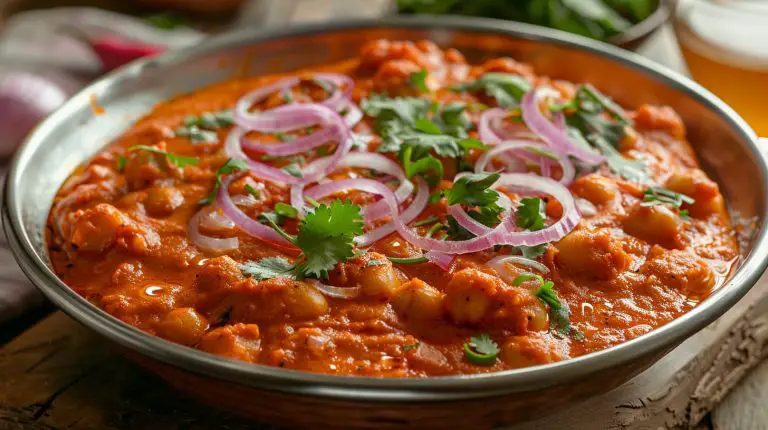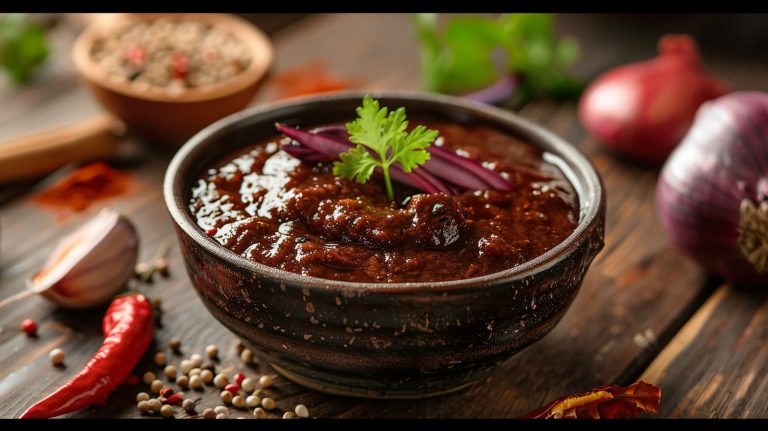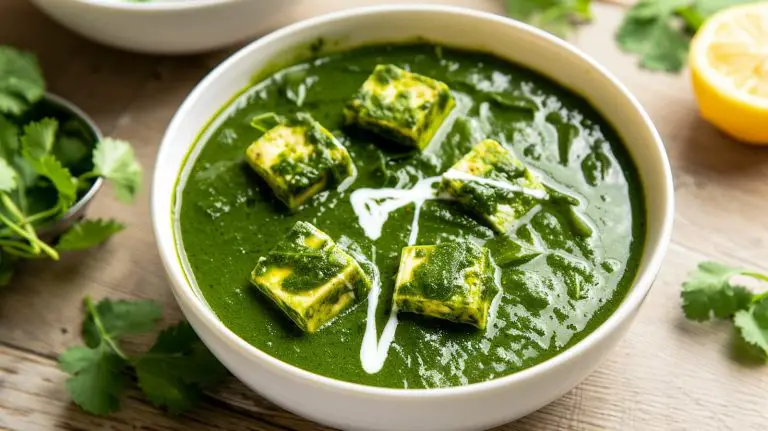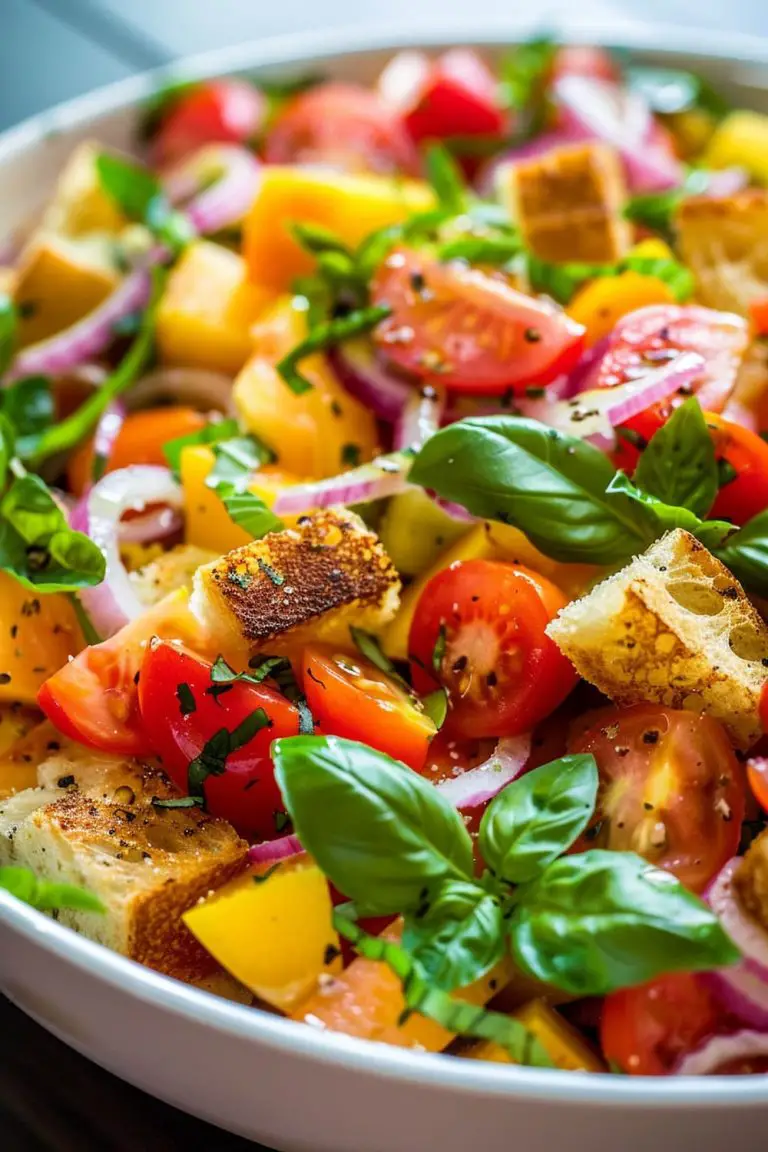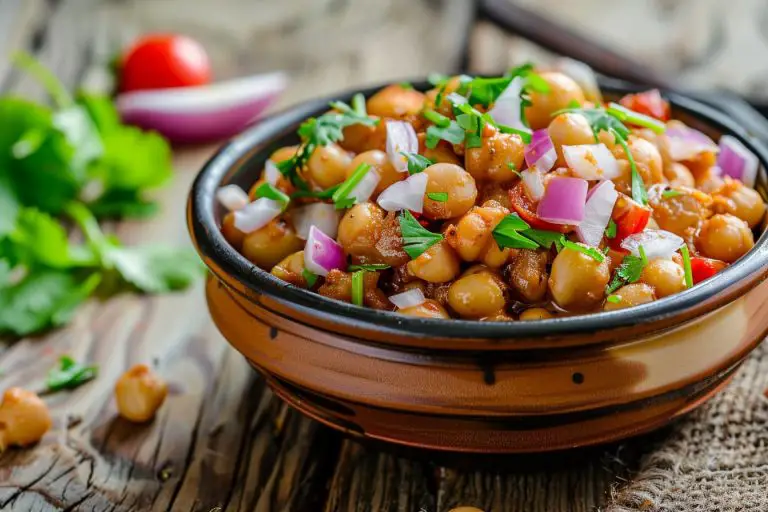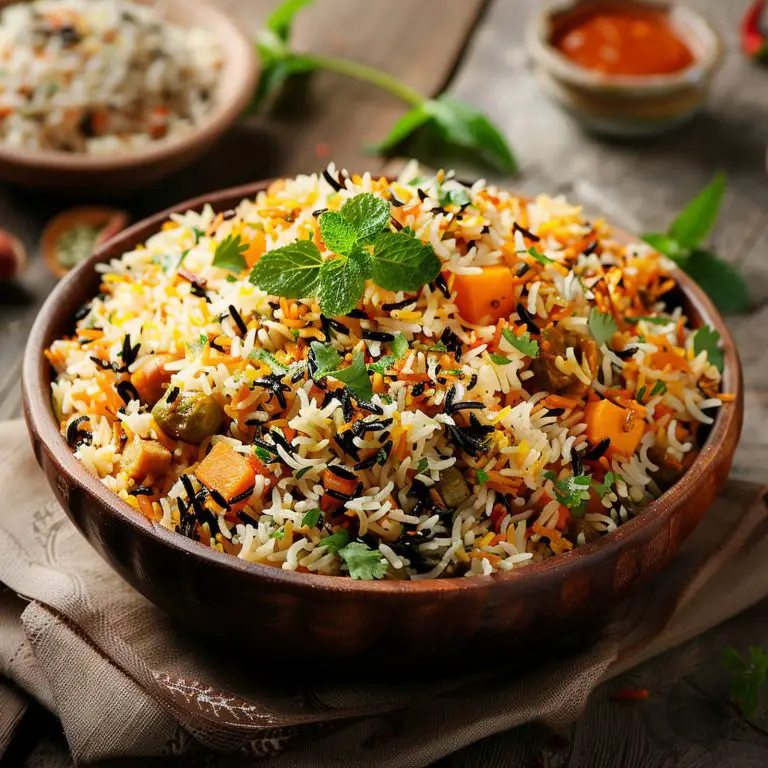Aloo Gobi Recipe (Potato Cauliflower Dry Curry)
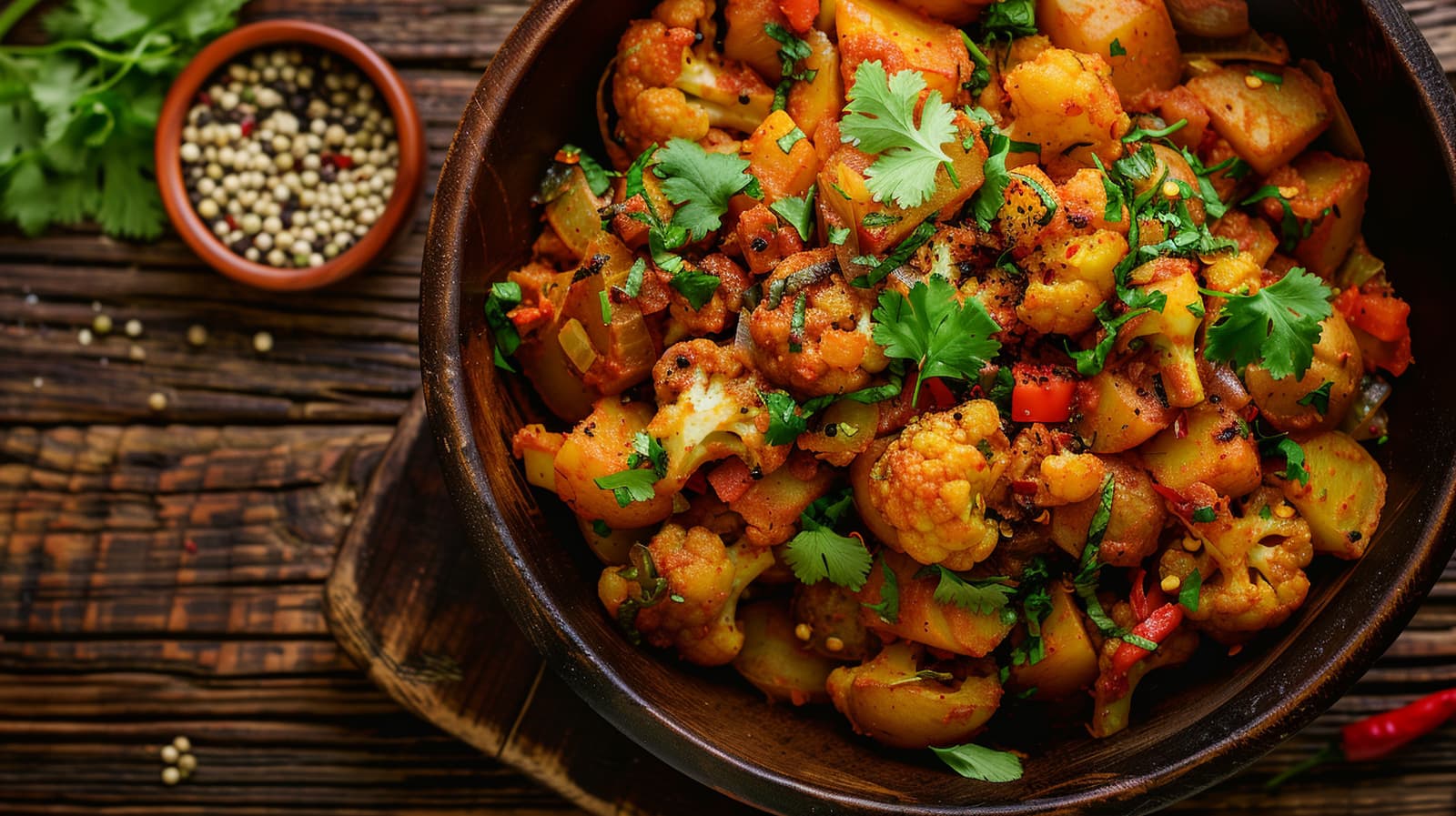
Aloo Gobi is a celebrated Indian recipe cherished across the globe for its comforting warmth and vibrant flavors.
In just 30 to 40 minutes, and with simple yet robust ingredients, you can create an authentic Indian masterpiece right in your kitchen. (and it’s surprisingly easy to make!).
- “Aloo Gobi” in Hindi translates to “Potatoes and Cauliflower,” highlighting the dish’s primary ingredients.
- Preparing Aloo Gobi involves roasting or sautéing cauliflower and potatoes with a medley of spices.
- It serves as a staple weeknight dinner and is perfect for those looking to indulge in the flavors of India without spending hours in the kitchen.
In this guide, you’ll learn
- How to make mouth-watering Aloo Gobi in your kitchen
- Common Mistakes To Avoid, Pro Tips To Enhance The Taste Of the Dish
- Pairing Suggestions and customization ideas for the recipe
- FAQs (Reader Questions Answered) and much more stuff!
So, grab your apron, and let’s dive in!
How to make Delicious Aloo Gobi (Potato Cauliflower Dry Curry) At Home
Ingredients:
Main Ingredients:
-
- 2 medium-sized potatoes, peeled and cut into cubes
- 1 medium-sized cauliflower, cut into florets
- 2 tablespoons of oil (coconut or olive oil for a healthier option)
- 1 teaspoon cumin seeds
- 1 large onion, finely chopped
- 2 teaspoons ginger-garlic paste
- 2 medium tomatoes, finely chopped
- Fresh cilantro for garnish
Spices:
-
- 1 teaspoon turmeric powder
- 1 teaspoon coriander powder
- 1/2 teaspoon red chili powder (adjust to taste)
- 1/2 teaspoon garam masala
- Salt to taste
Allergen-Free Substitutes:
-
- Gluten-free: This recipe is naturally gluten-free.
- Dairy-free: No dairy products are used in this recipe.
Instructions:
Preparation:
-
- Begin by washing the potato cubes and cauliflower florets thoroughly. Let them drain to remove excess water, or pat dry with a kitchen towel.
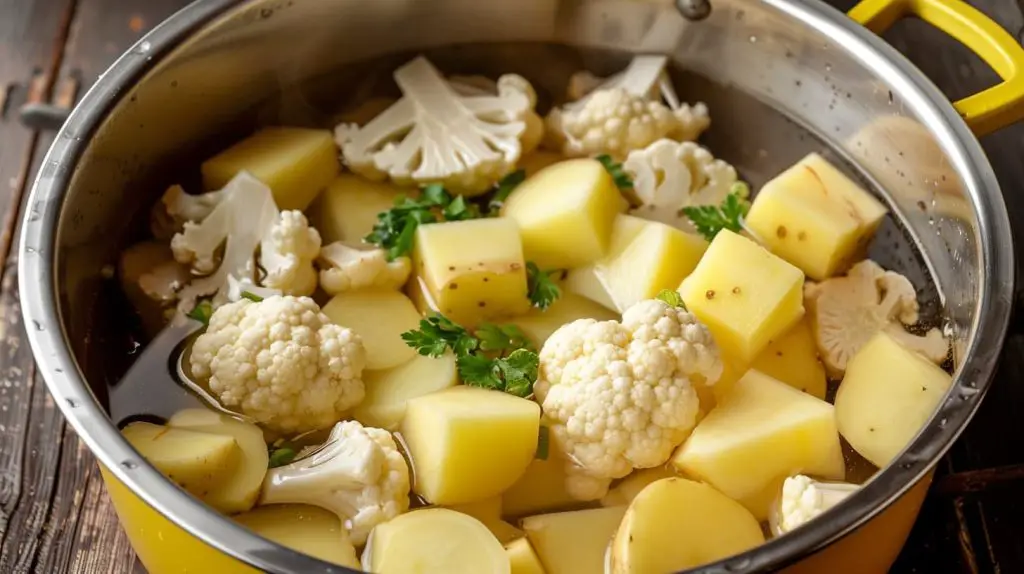
Cooking the Vegetables:
-
- Heat the oil in a large, heavy-bottomed pan over medium heat. For a healthier alternative, use olive oil or coconut oil, which has beneficial fatty acids and a higher smoke point.
- Add cumin seeds and let them sizzle for a few seconds until aromatic.
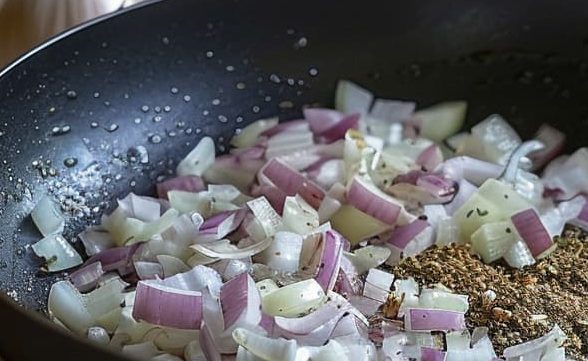
- Stir in the finely chopped onions and sauté until they turn golden brown. This is your flavor base; the onions should be well caramelized but not burnt.
- Add the ginger-garlic paste, sautéing for another minute to cook off the raw flavors.
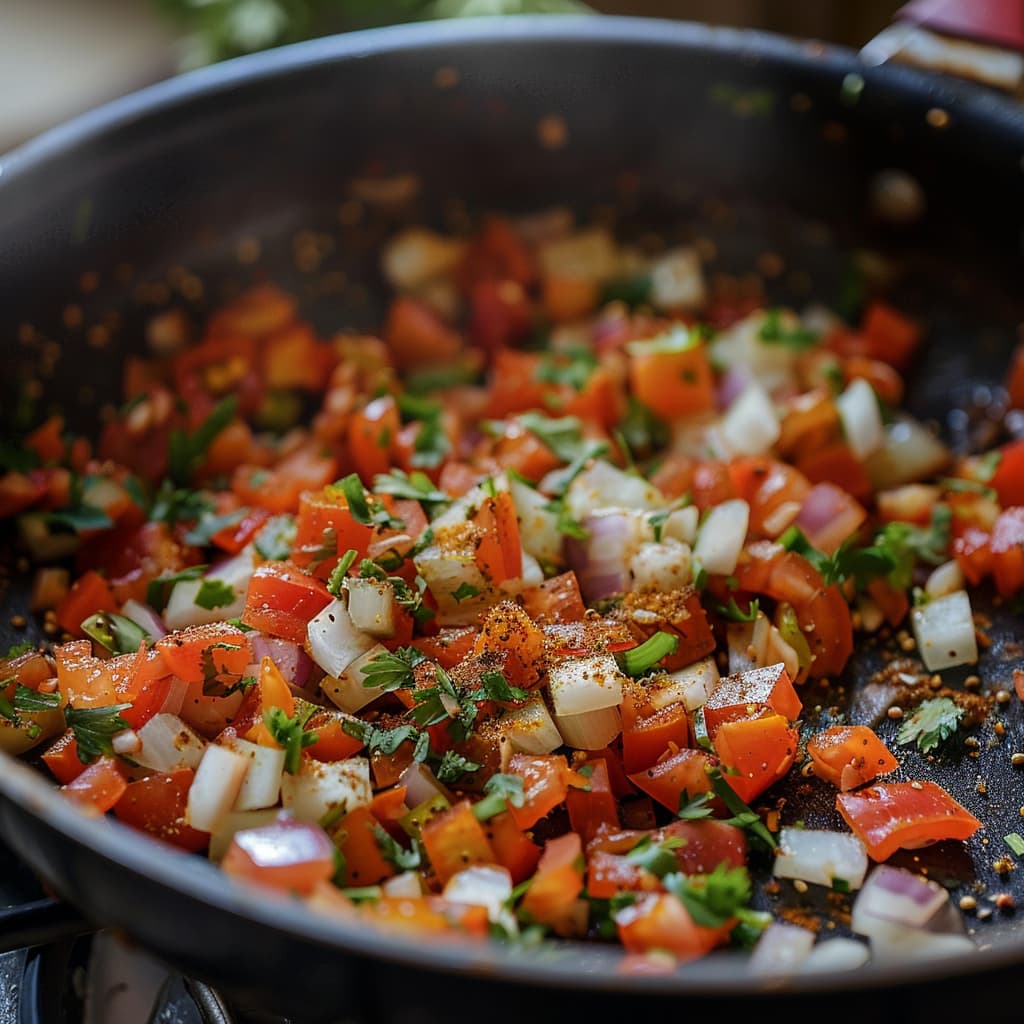
- Introduce the chopped tomatoes and cook until they break down into a soft, mushy consistency, creating a rich gravy base. This is crucial for imbuing the dish with its signature tangy taste.
Spicing it up:
-
- Sprinkle in the turmeric, coriander, and chili powders, stirring well to incorporate. The spices should roast slightly in the mix, becoming fragrant but not burnt.
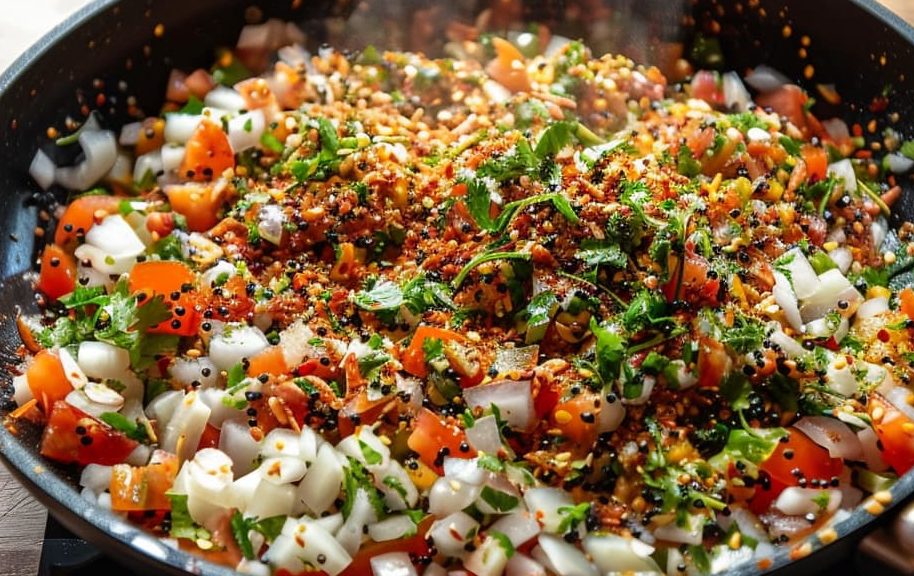
- For a health-conscious twist, ensure your spices are organic and freshly ground to maximize their health benefits and flavor.
Adding the Vegetables:
-
- Mix in the potato cubes, coating them evenly with the spice mix. Cover and cook for about 5 minutes.
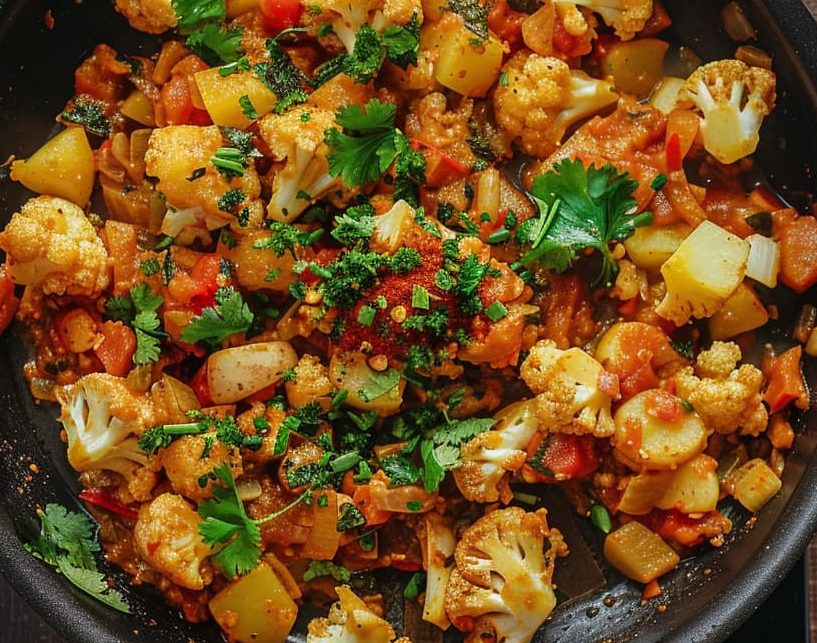
-
- Add the cauliflower florets, gently folding them into the spice-coated mixture. Season with salt. Cover the pan and let the vegetables cook on a medium-low flame.
- Stir occasionally, and if the mixture seems too dry, add a splash of water. This steaming process helps retain the nutrients in the vegetables while making them tender. But don’t add too much water as this dish is preferred as a dry preparation.
Finishing Touches:
-
- Once the vegetables are cooked but still hold their shape, sprinkle garam masala over the top. Mix gently.
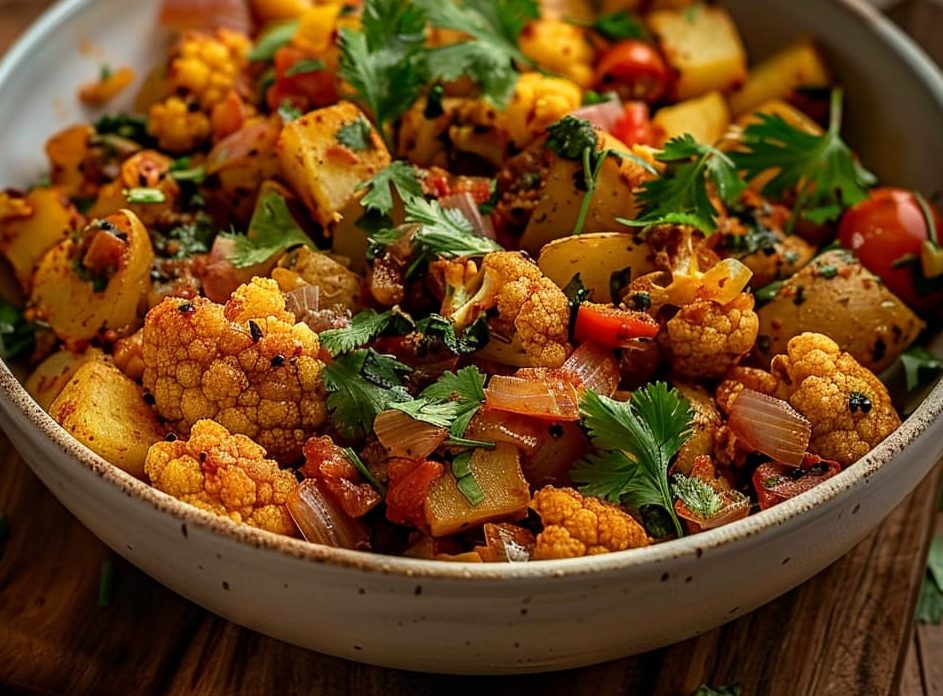
- Garnish with freshly chopped cilantro for a burst of color and freshness.
Serving:
Serve your Aloo Gobi hot, with a side of fluffy basmati rice or warm, gluten-free rotis.
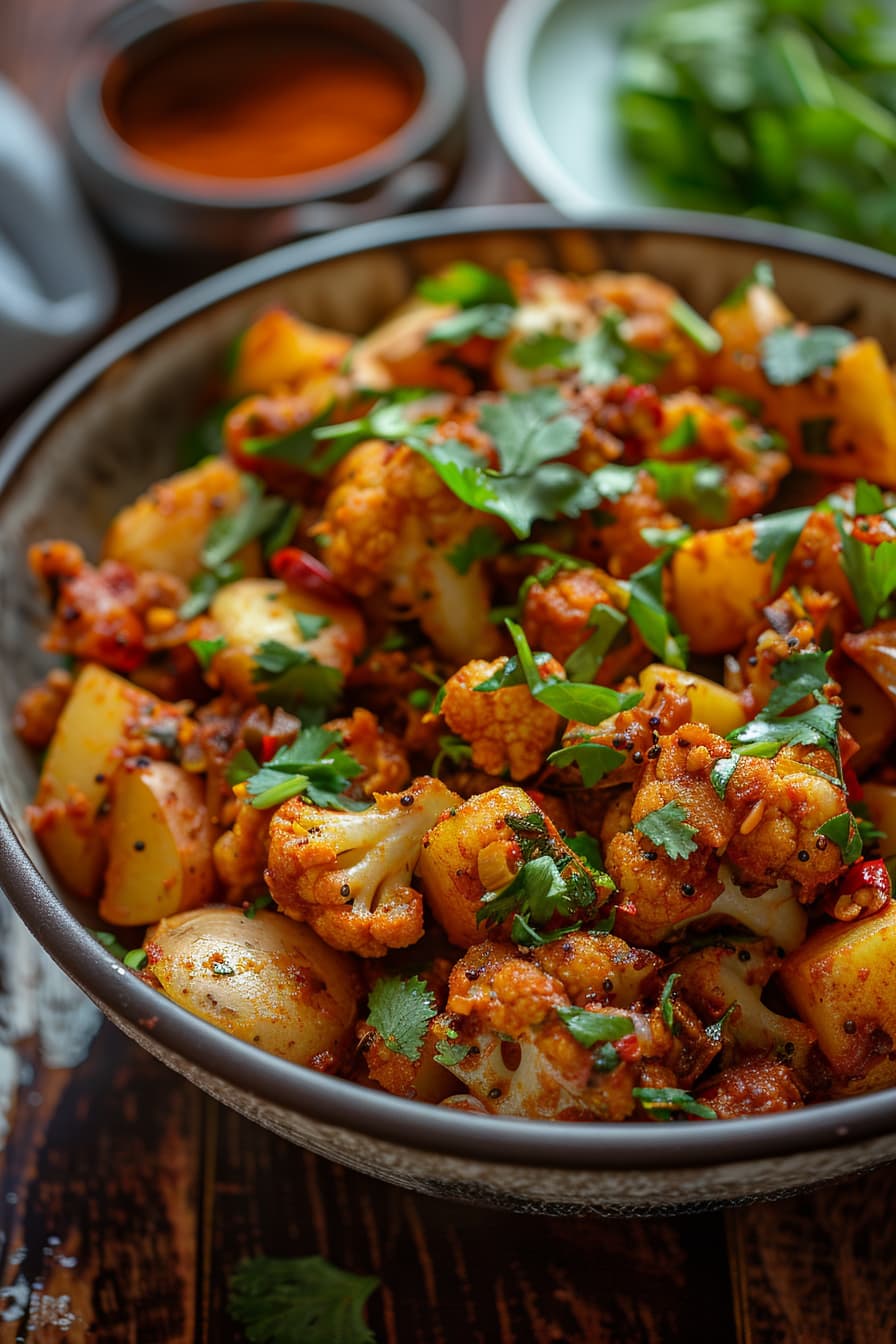
Contemporary takes on Aloo Gobi include adding coconut milk for a creamy texture, incorporating new vegetables like peas or bell peppers, or even giving it a fusion twist by serving it as a filling in tacos or wraps.
Customization Ideas for Aloo Gobi (Potato Cauliflower Dry Curry):
While traditionally made with potatoes, cauliflower, and a handful of spices, Aloo Gobi welcomes variations.
- In the northern regions, it’s typically made with a tomato-based sauce and a generous amount of ginger, giving it a hearty flavor.
- Southern versions might include curry leaves and mustard seeds, adding a distinctive aroma and tang.
- In the eastern parts, a hint of sweetness can be present, whereas the western adaptation might be spicier with the use of different chili peppers.
- You can easily adapt it to include your favorite veggies like the addition of peas, and alternative proteins like paneer or tofu, making it a perfect fit for different dietary preferences or meal times.
Mistakes To Avoid While Making Aloo Gobi (Potato Cauliflower Dry Curry)
Creating the perfect Aloo Gobi is an art that balances flavor, texture, and aroma. Here’s how to navigate common pitfalls, ensuring a delightful dish every time.
Ingredient Selection:
- Mistake: Using old potatoes or cauliflower that’s not fresh can lead to a lackluster dish.
- Solution: Select firm, fresh potatoes and cauliflower. Fresh produce should not have any soft spots or discolorations. For potatoes, choose varieties that hold their shape well after cooking, like Yukon Gold or Red potatoes.
Preparation Pitfalls:
- Mistake: Cutting the vegetables into inconsistent sizes leads to uneven cooking.
- Solution: Chop the potatoes and cauliflower into uniform pieces to ensure they cook evenly. This also helps in absorbing the spices uniformly, enhancing the overall flavor.
Cooking Techniques:
- Mistake: Overcooking the vegetables, turning them mushy.
- Solution: Keep an eye on the cooking time. Start by cooking the potatoes for a few minutes before adding the cauliflower, as potatoes take longer to cook. Test the vegetables for doneness by piercing them with a fork. They should be tender but still hold their shape.
- Mistake: Using too much oil can make the dish greasy.
- Solution: Use a minimal amount of oil just enough to sauté the spices and coat the vegetables. If you’re health-conscious, consider using a non-stick pan to reduce the oil further.
Seasoning and Flavoring:
- Mistake: Over or under-seasoning the dish.
- Solution: Taste as you go. Start with a conservative amount of spices, as you can always add more, but it’s difficult to correct over-seasoning. Remember, the spices are the soul of Aloo Gobi; getting the balance right is key to its authentic flavor.
Pairing Suggestions for Aloo Gobi (Potato Cauliflower Dry Curry)
- Beverages: A refreshing lassi, either sweet or salted, complements the spices in Aloo Gobi beautifully. For a more global palate, a crisp white wine or a light-bodied beer can balance the richness of the spices. However, if you have digestive issues, it is recommended to not drink any kind of beverages with spicy dishes.
- Side Dishes: Serve Aloo Gobi with soft, warm naan or roti to soak up the flavors. A side of dal (lentil soup) adds protein and complements its texture and taste, making for a well-rounded meal.
- Main Courses: Pairing Aloo Gobi with basmati rice or jeera rice (cumin seed rice) makes for a simple yet satisfying meal. For a feast, include it as a side dish alongside other Indian favorites like Indian Butter Chicken or Paneer Tikka Masala.
Seasonal Variation for Aloo Gobi (Potato Cauliflower Dry Curry)
- Spring: Incorporate green peas or asparagus to add a fresh, sweet contrast to the earthy spices.
- Summer: Add a tangy twist with cherry tomatoes or bell peppers, offering a colorful and light freshness suitable for hotter months.
- Autumn: Mix in some sweet potato or pumpkin for a sweet, earthy depth that harmonizes with autumnal flavors.
- Winter: Consider adding hearty root vegetables like turnips or carrots, which can withstand the robust flavors and add a comforting element during colder months.
Always Keep In Mind, that the inclusion of newer veggies or spices can end up impacting the overall taste of the dish, so you may need to adjust your other spices or salt portions to counter that.
Common Problems You May Face While Cooking Aloo Gobi (Potato Cauliflower Dry Curry)
Overcooking Vegetables:
- Problem: It’s easy to overcook the cauliflower and potatoes, turning them mushy instead of tender yet firm.
- Solution: Keep an eye on your cooking time and test the vegetables for doneness by piercing them with a fork. Cauliflower cooks faster than potatoes, so consider adding it a bit later into the pan.
Spices Not Well Integrated:
- Problem: Sometimes the spices might end up unevenly distributed, leading to some bites being spicier than others.
- Solution: Ensure you’re toasting your spices briefly in oil before adding the vegetables. This step helps release their flavors and ensures they coat the vegetables evenly.
The Dish Is Too Dry or Too Oily:
- Problem: Finding the right balance of moisture without the dish becoming too oily can be tricky.
- Solution: Start with minimal oil and add more if needed. If the dish seems too dry, add a splash of water and cover it to steam the vegetables slightly.
Burnt Spices:
- Problem: Spices can burn if cooked on high heat without enough oil, ruining the dish’s flavor.
- Solution: Cook your spices on a medium flame and constantly stir them. If they start sticking, add a little bit of water to the pan to prevent burning.
Flavor Balance:
- Problem: Getting the right balance of spices can be daunting, leading to the dish being too bland or too spicy.
- Solution: Start with smaller quantities of spices; you can always add more according to taste. Remember, it’s easier to add more flavor than to correct an overly spiced dish.
Sticky Potatoes:
- Problem: Potatoes can sometimes become sticky and not as crisp as desired.
- Solution: Make sure the potatoes are thoroughly dried after washing, and avoid overcrowding in the pan to allow them to cook evenly.
Uncertainty about the finishing:
- Problem: Knowing when the dish is perfectly cooked can be uncertain, especially for beginners.
- Solution: The key to perfect Aloo Gobi is tender potatoes that aren’t falling apart and cauliflower that’s cooked and soft but still offers a bit of resistance. Taste test as you go to ensure vegetables are cooked to your liking.
Pro Tips for Perfecting Aloo Gobi (Potato Cauliflower Dry Curry)
- Blanch the cauliflower: Before adding cauliflower to the curry, blanch it in hot water for a couple of minutes. This helps to soften the cauliflower slightly, making it easier to cook through while maintaining its texture.
- Control moisture: Cauliflower tends to release moisture as it cooks, which can make the curry watery. To prevent this, cook the curry uncovered on medium heat, allowing excess moisture to evaporate.
- Don’t overcook: Aloo Gobi tastes best when the vegetables are cooked through but still retain some texture. Avoid overcooking, which can make the vegetables mushy and compromise their flavor and texture.
FAQs about Aloo Gobi (Reader Questions Answered)
Can I use frozen cauliflower and potatoes?
- Solution: Yes, you can use frozen cauliflower and potatoes. Thaw them and pat dry to remove excess moisture before cooking to maintain the texture.
How do I prevent the spices from burning?
- Solution: Cook spices on medium heat and keep stirring. If they start to stick, add a tiny bit of water to the pan.
What if I don’t have a specific spice mentioned in the recipe?
- Solution: Feel free to omit a spice or substitute it with something you have on hand. Garam masala can often replace several individual spices.
Can Aloo Gobi be made in advance?
- Solution: Yes, it can be prepared in advance and refrigerated. Store in an airtight container and reheat on the stove or in the microwave, adding a little water if needed to prevent drying out.
Is there a way to make this dish less spicy?
- Solution: Reduce the amount of chili powder or green chilies to adjust the heat level according to your preference.
How can I make Aloo Gobi in a pressure cooker?
- Solution: To adapt the recipe for a pressure cooker, reduce the amount of water, and pressure cook for a shorter time since both cauliflower and potatoes cook quickly under pressure.
Can I add other vegetables to this dish?
- Solution: Absolutely! Feel free to include peas, carrots, or beans. Just adjust cooking times accordingly.
Can I make Aloo Gobi in an Instant Pot?
- Solution: Yes, you can make it in an Instant Pot. Use the sauté function to fry the spices and vegetables briefly before switching to pressure cook mode. Adjust liquid amounts since less evaporation occurs compared to traditional cooking.
How can I keep my Aloo Gobi from becoming mushy?
- Solution: To prevent mushiness, cook on medium heat and avoid over-stirring. Also, cut the cauliflower into large florets and the potatoes into thick pieces to maintain their structure.
What can I substitute for cauliflower or potatoes if I don’t have them on hand?
- Solution: For cauliflower, you can use broccoli or Romanesco for a similar texture. For potatoes, try sweet potatoes for a sweet contrast or turnips for a similar texture.
Is Aloo Gobi gluten-free and vegan?
- Solution: Yes, Aloo Gobi is naturally gluten-free and vegan, making it a great option for those with dietary restrictions.
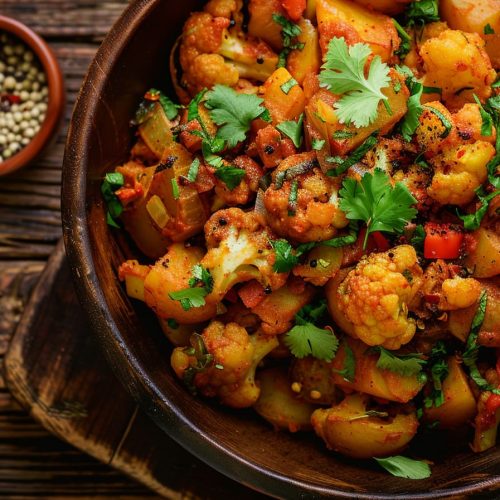
Aloo Gobi Recipe (Potato Cauliflower Dry Curry)
Ingredients
Main Ingredients:
- 2 medium-sized potatoes peeled and cut into cubes
- 1 medium-sized cauliflower cut into florets
- 2 tablespoons of oil coconut or olive oil for a healthier option
- 1 teaspoon cumin seeds
- 1 large onion finely chopped
- 2 teaspoons ginger-garlic paste
- 2 medium tomatoes finely chopped
- Fresh cilantro for garnish
Spices:
- 1 teaspoon turmeric powder
- 1 teaspoon coriander powder
- 1/2 teaspoon red chili powder adjust to taste
- 1/2 teaspoon garam masala
- Salt to taste
Instructions
Preparation:
- Begin by washing the potato cubes and cauliflower florets thoroughly. Let them drain to remove excess water, or pat dry with a kitchen towel.
Cooking the Vegetables:
- Heat the oil in a large, heavy-bottomed pan over medium heat. For a healthier alternative, use olive oil or coconut oil, which has beneficial fatty acids and a higher smoke point.
- Add cumin seeds and let them sizzle for a few seconds until aromatic.
- Stir in the finely chopped onions and sauté until they turn golden brown. This is your flavor base; the onions should be well caramelized but not burnt.
- Add the ginger-garlic paste, sautéing for another minute to cook off the raw flavors.
- Introduce the chopped tomatoes and cook until they break down into a soft, mushy consistency, creating a rich gravy base. This is crucial for imbuing the dish with its signature tangy taste.
Spicing it up:
- Sprinkle in the turmeric, coriander, and chili powders, stirring well to incorporate. The spices should roast slightly in the mix, becoming fragrant but not burnt.
- For a health-conscious twist, ensure your spices are organic and freshly ground to maximize their health benefits and flavor.
Adding the Vegetables:
- Mix in the potato cubes, coating them evenly with the spice mix. Cover and cook for about 5 minutes.
- Add the cauliflower florets, gently folding them into the spice-coated mixture. Season with salt. Cover the pan and let the vegetables cook on a medium-low flame.
- Stir occasionally, and if the mixture seems too dry, add a splash of water. This steaming process helps retain the nutrients in the vegetables while making them tender. But don't add too much water as this dish is preferred as a dry preparation.
Finishing Touches:
- Once the vegetables are cooked but still hold their shape, sprinkle garam masala over the top. Mix gently.
- Garnish with freshly chopped cilantro for a burst of color and freshness.
Serving:
- Serve your Aloo Gobi hot, with a side of fluffy basmati rice or warm, gluten-free rotis.

